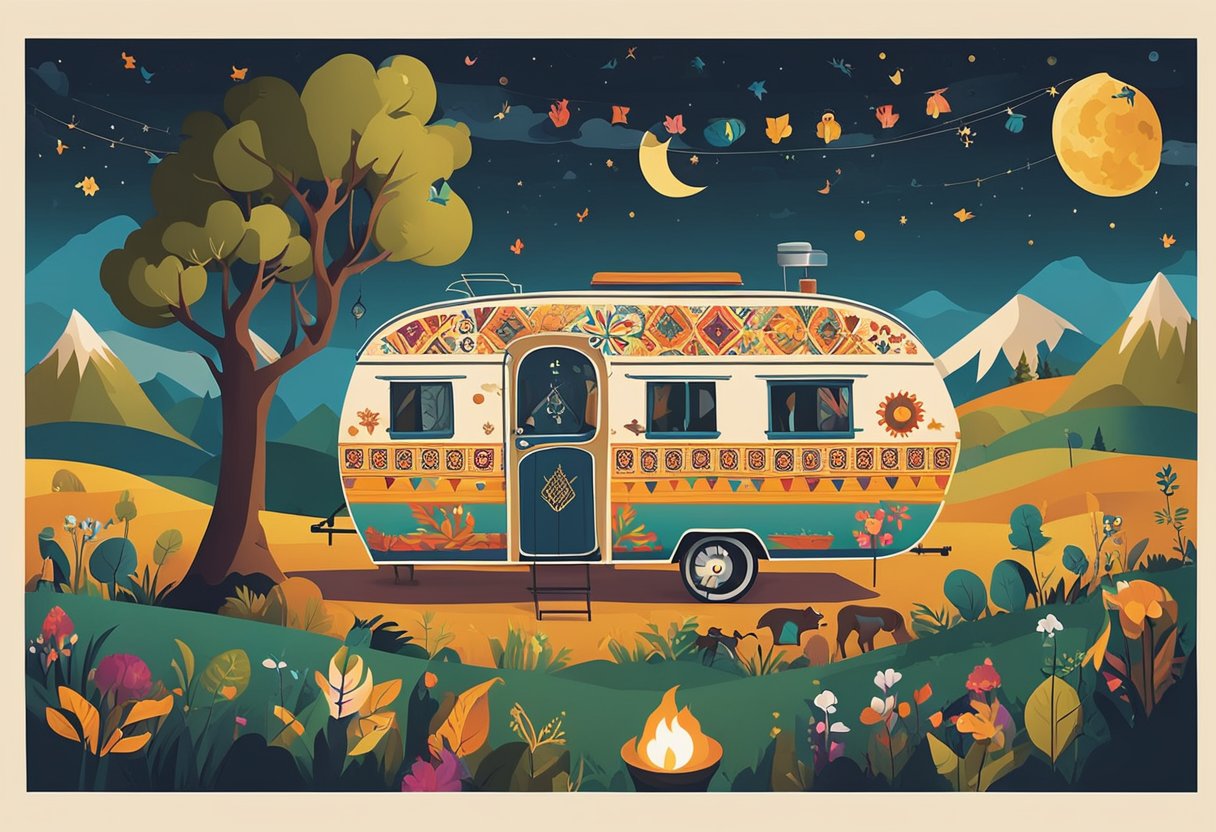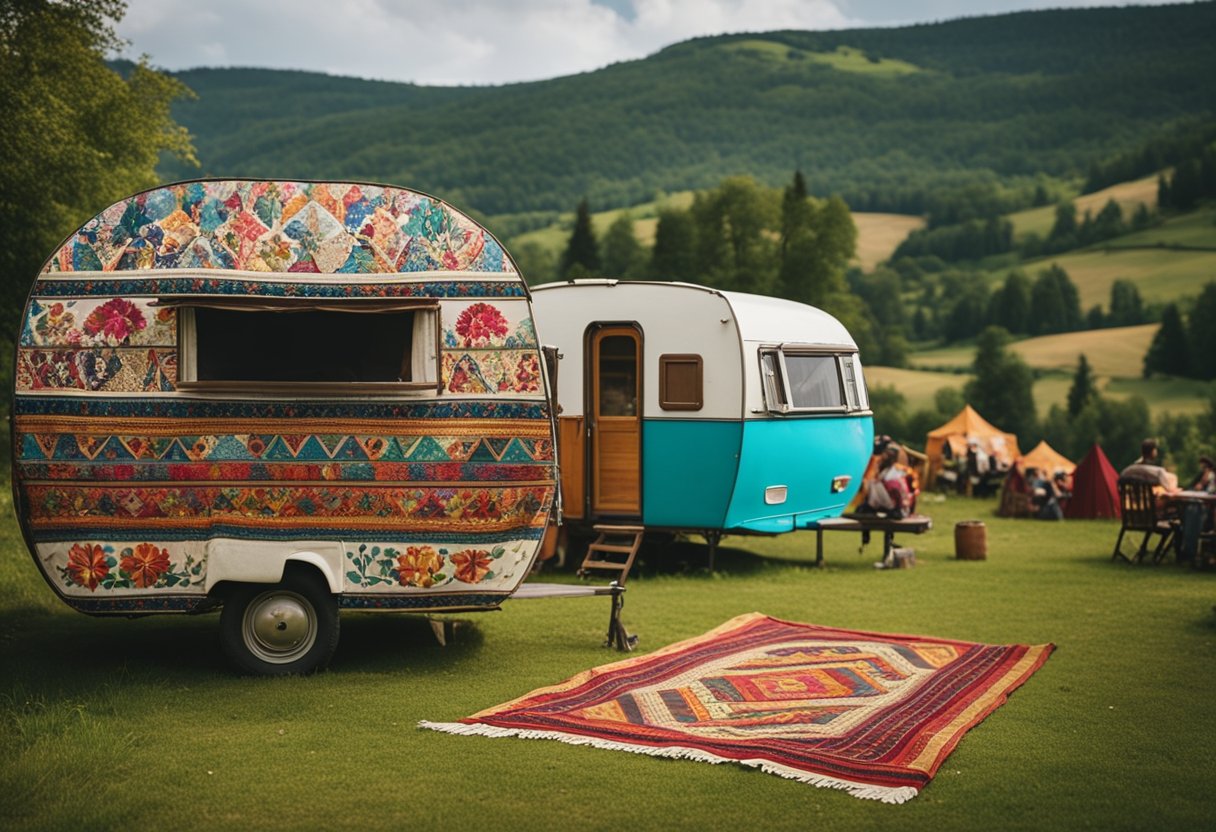The Gypsy Trail: Exploring Romani Heritage and Practices Across the Continent

Updated On: April 07, 2024 by Marwa Alaa
The Gypsy Trail weaves through Europe like a vibrant tapestry of colours, embodying a rich mosaic of Romani culture and traditions that have evolved over centuries. As a distinct ethnic group, the Roma have navigated a path marked by a complex history, influencing and being influenced by the diverse regions of Europe they traversed. Their cultural practices, language, and social structures are a testament to their resilience and ability to adapt whilst maintaining a strong sense of identity.

The rituals, customs, and daily life of the Roma are an intricate interplay of tradition and modernity. While often misunderstood and facing historical patterns of discrimination, their cultural expressions—through music, dance, and art—remain pivotal in telling the story of a people who have contributed significantly to European heritage. Romani religious beliefs and linguistic ties serve as unifying threads for communities scattered across continents and speak to the enduring spirit of a people that defy simple categorisation.
Table of Contents
Gypsy Trail: Historical Origins and Migration of the Romani People
Before we delve into the intricate history of the Romani people, it’s crucial to understand their beginnings and subsequent dispersions across Europe. The Romani commenced their remarkable journey from Northern India, traversed through the Middle East, and eventually spread throughout Europe, influencing cultures and societies in their wake.
The Gypsy Trail: From Northern India to Europe
The Romani people began their extensive migration from Northern India, where they shared linguistic connections with the Sanskrit-speaking people. Anthropological and linguistic evidence supports their journey from the region, with the Romani language containing elements of Sanskrit. By crossing Persia and the Byzantine Empire during their early movements, they paved a path that would lead them to Europe.
The Roma Diaspora in the Medieval Era
Throughout the Middle Ages, the Roma diaspora progressed throughout Europe. The separation into distinct groups, such as the Roma, Sinti, and Kale, occurred through this era, characterised by their adaptability and resilience in the face of societal changes and challenges they encountered.
Romani Presence in the Ottoman Empire
During their migration, the Romani people also established a presence within the vast territories of the Ottoman Empire. Many found refuge and a new life under Ottoman rule, which offered a distinct social environment compared to Western Europe. Their skills in craftsmanship and trade facilitated their integration into the empire’s diverse population.
Throughout this historical traversal, the Romani have preserved their rich culture and traditions, which remain a vibrant part of Europe’s cultural mosaic today.
Romani Language and Linguistics
The rich tapestry of the Romani language reflects a centuries-long journey across Europe, encapsulating a unique blend of linguistic traits and a history of preservation. Our exploration delves into the language’s diverse dialects, efforts to sustain its use, and deep Indo-European roots.
Dialects and Influences
Romani language showcases a variety of dialects influenced by the regions where Romani communities have resided. Regional languages have left an imprint on the Romani language, enriching its vocabulary and syntax. The impact of languages like Sanskrit, Hindi, Punjabi, and Urdu is discernible, reflecting the language’s origin and the migration paths of the Romani people. For instance, Vlax Romani, one of the most widely spoken dialects, possesses terms and structures heavily influenced by Balkan languages due to centuries of cohabitation.
Linguistic Preservation
Efforts for linguistic preservation of Romani are crucial in maintaining cultural identity. Despite the external influences and dispersion of the Romani people, there is a conscious effort to retain the purity and nuances of their language. Educational resources and scholarly works, such as The Palgrave Handbook of Romani Language and Linguistics, play a pivotal role in documenting and teaching the language to both Romani and non-Romani speakers.
Romani and Indo-European Connections
Romani’s deep connections with the Indo-European family are undeniable, with roots traced back to ancient languages like Sanskrit. Linguistic comparisons reveal that Romani retains core elements of its Indo-Aryan origins, making it a significant subject for scholars studying language evolution and the migration of peoples from the Indian subcontinent to Europe. Romani not only shares structural parallels with languages like Hindi but also contains elements of phonology and grammar that are indicative of its historical journey through Persia and the Byzantine Empire before settling across Europe.
Cultural Practices and Social Structure

In Romani communities, cultural practices are intricately linked to their social structure, forming a strong foundation for community life. Our examination here focuses on family and kinship ties, marriage customs, and the pivotal role of elders and community hierarchies in preserving tradition and maintaining social cohesion.
Family and Kinship
Romani societies place immense value on family and kinship networks. These extended family systems are bound by shared responsibilities and mutual support, with a deep emphasis on maintaining family honour. The Romani extended family often functions as a singular unit, sustaining a close-knit community life tethered by collaborative social and economic interactions. Hospitality is a hallmark of Romani kinship, considered both a duty and a pride when engaging with others, be it within or outside the community.
Marriage Customs
Marriage among the Romani is not just a union of two individuals but a robust bond between families, often negotiated to strengthen kinship ties. Traditional marriages are commemorated with elaborate ceremonies displaying a rich tapestry of customs that signify the importance of marital ties. In many cases, these unions are arranged, and whilst the age of marriage can vary, a significant value is placed on the sanctity and longevity of the marital promise.
The Role of Elders and Hierarchies
The hierarchy within Romani communities offers a framework which upholds the cultural identity and codes of conduct. Elders, especially women known as phuri dai, are revered for their wisdom and serve as custodians of customs, storytelling, and dispute resolution. These elders preside over community matters, their authority rooted in tradition rather than formal structures, supporting the (often patriarchal) fabric of Romani society where respect for seniority informs decision-making processes.
Everyday Life and Traditions

As we trace the Gypsy Trail, we find that Romani culture is marked by rich traditions and a unique way of life that has been carried on for centuries through nomadism, music, dance, and storytelling.
Nomadism and Settlement
The Romani people have historically been associated with a nomadic lifestyle, travelling in caravans and setting up camps across Europe. While nomadism remains a cornerstone of Roma identity, many have also embraced a settled existence, often forming tight-knit communities in various European countries. This shift has allowed them to maintain their cultural practices while adapting to the surrounding society.
Music and Dance
Music and dance are pillars of Romani culture, deeply ingrained in daily life and festivities. Romani musicians are renowned for their contributions to the musical landscape, including the prodigious composer Liszt, whose “Gypsy-inspired” melodies reflect the deep connection to this vibrant musical heritage. From lively dances to soulful melodies, music remains a potent expression of Romani spirit and communal bonds.
Oral Traditions and Storytelling
Romani culture is rich in oral tradition and storytelling, which serve as the primary means of preserving history, laws, and morals. Stories passed down through generations encapsulate the wisdom and experiences of the Roma, instilling a sense of pride and continuity. This tradition of storytelling underpins the community’s values, such as generosity and resilience, cementing a collective cultural identity that withstands the test of time.
Romani Religious Beliefs
In exploring the patchwork of Romani religious beliefs, we find a tapestry rich with diverse threads, each influenced by regional religions. The Romani people often adopt the dominant religion of the region they inhabit, yet their spiritual practices often reflect a unique blend of traditions.
Christian Influences
As the Romani dispersed across Europe, many have come into contact with and adopted forms of Christianity. In regions where the Christian faith is prevalent, it’s common to find Romani individuals integrating Christian teachings and symbolism into their religious practice. For instance, Romani groups in predominantly Catholic countries might observe Christian holidays and participate in church services while maintaining traditional Romani spiritual customs.
Islam and Romani Muslims
Similarly, in regions where Islam is widely practised, many Romani have embraced the Muslim faith, resulting in communities of Romani Muslims. Their Islamic practice is often coloured by Romani culture, with traditional customs and beliefs finding synergy with Muslim tenets. These Romani Muslims faithfully observe Islamic rituals and consider the Quran a central pillar of their spiritual life.
Religion as a Cultural Blend
Our observation reveals that Romani spirituality is not a monolithic structure but rather a cultural blend of various religious elements. While the adopted religion—be it Christianity or Islam—provides a framework, the intricate Romani spiritual heritage enriches their religious experience, creating a unique mosaic that varies from one Romani community to another.
Patterns of Discrimination and Persecution
The Romani people have faced continued discrimination and persecution throughout history. Our examination will focus on the historical context, instances during World War II, and modern challenges to give a comprehensive understanding of these patterns.
Anti-Romani Sentiment in History
Historically, anti-Romani sentiment has been prevalent across Europe. Since their arrival in Europe from the Indian subcontinent around the 14th century, Romani communities have often been viewed with suspicion and targeted with various forms of persecution. In Eastern Europe, where they are the largest ethnic minority, the Roma have been enslaved, segregated, and subjected to assimilation policies. The discrimination towards Roma is deeply rooted in the fabric of European history and has manifested in social, economic, and political marginalisation.
The Persecution During World War II
The plight of the Roma reached horrifying magnitudes during World War II. Under Nazi rule, they were subjected to genocide alongside Jews and other groups in what is known as the Porajmos, or Romani Holocaust. Hundreds of thousands of Romani people were murdered, and their communities were destroyed. This tragic chapter is a stark reminder of the consequences of unchecked racism and prejudice.
Modern Prejudices and Stereotypes
In the present day, the Roma continue to face systemic discrimination marked by social and institutional barriers. Stereotypes and misconceptions about the Roma are still widespread, often fuelling racist attitudes and discriminatory practices in education, healthcare, and housing. Reports have shown that Gypsy, Roma, and Traveller children are over-represented in child welfare services in England. Moreover, these communities frequently confront challenges to their way of life, with anti-Romani laws and societal prejudice forcing many to the peripheries of society.
Romani Arts and Contributions
The Romani people have a rich artistic heritage, with their cultural expressions spanning various domains, from music to literature. We’ll take a closer look at the standout figures, their influence on European culture, and how their stories have been told in literature and media.
Prominent Romani Personalities
Musicians: Romani musicians have profoundly impacted European music. Franz Liszt, the renowned Hungarian composer, was greatly influenced by Romani music, as evidenced by his rhapsodies that echo their vibrant tones. This melding of Romani scales and European classical forms is a testament to the depth of Romani musical traditions.
Contribution to European Culture
- Oral Tradition: The Romani are custodians of a rich oral tradition that has permeated European culture. This includes folk tales, music, and dances that have been passed down and adapted across generations, preserving their history and identity.
- Influence on Arts: Romani contributions aren’t confined to music alone; their distinctive style has also found its way into visual arts, influencing the colourful tapestry of European folk art.
Representation in Literature and Media
Romani characters and narratives have often been featured in European literature and media, albeit sometimes stereotypically. However, contemporary depictions are working towards a more nuanced representation, providing insights into the diverse experiences and customs of Romani communities. By capturing elements of the Romani journey, literature and media contribute to a broader understanding of their intricate cultural mosaic.
Social and Political Movements

In our pursuit of understanding the Romani trail, we recognise that the social and political movements of the Roma have been pivotal in challenging discrimination and advocating for their rights. Historical contexts have shaped these movements, giving voice to communities that have long strived for recognition and equality.
Fight for Rights and Recognition
Discrimination against the Roma people has been a persistent issue throughout Europe. The Roma have mobilised to combat societal exclusion and false narratives. An example is the notable increase in the involvement of children in the foster care system, demonstrating the urgent need for socio-political change. Efforts by various groups have focused on addressing such issues, with many advocating for the protection of Romani culture and the rights of these traditionally marginalised communities.
International Romani Union
Formed as an embodiment of unity and political advocacy, the International Romani Union is a significant organisation championing the rights of Romani people globally. Its foundation illustrates the endeavours of the Roma to create formal structures that not only preserve their cultural identity but also promote political engagement. Such entities empower the Romani to voice their concerns on an international stage.
Advocacy and Open Society Involvement
Groups like the Open Society have been instrumental in supporting the Roma in their fight against discrimination and social injustice. They have provided essential aid to Roma support groups, ensuring that the plight of the Romani people is not overlooked. These organisations play a crucial role in nurturing the social fabric that sustains Roma communities across Europe and globally. Their active participation aids in the gradual dismantling of cultural and socio-political barriers.
Frequently Asked Questions
We’ve compiled a shortlist of some common questions that arise regarding Romani culture and traditions in Europe.
What are the common traditions and customs observed by Roma gypsies?
The customs and traditions of the Roma people vary widely and include a strong oral tradition, a distinctive music style, and traditional costumes. Ceremonial events such as weddings and funerals are particularly rich in ritual and often involve large gatherings of family and community.
Which superstitions and beliefs hold significance in Romani culture?
Many Roma hold superstitions and beliefs that pertain to the spirit world, luck, and cleanliness. These beliefs have been passed down through generations and continue to influence many aspects of daily life.
In what ways do the Romani people adhere to distinct societal rules?
Romani communities typically follow a set of internal societal rules that govern interactions both within the group and with outsiders. These can include concepts of purity, honour, and family loyalty, which play a pivotal role in interpersonal relationships and community structure.
Could you list some prominent figures from the Romani community?
Throughout history, there have been many prominent figures of Romani heritage, including artists, musicians, writers, and activists, who have contributed to the cultural tapestry of Europe and the world.
How has the Romani language contributed to their cultural identity?
The Romani language stands as a vital element of cultural identity among Roma, encompassing a variety of dialects which are still spoken today. It carries rich idiomatic expressions that reflect their history and nomadic heritage.
What religious practices are predominantly followed within Romani communities?
Romani people often adopt the predominant religion of the country in which they reside, which can include Christianity and Islam, while also maintaining distinct religious practices and rituals that are unique to their culture and traditions.






